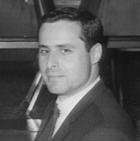Peter Buxtun

Peter Buxtun (sometimes referred to as Peter Buxton; born 1937 in Prague[1]) is a former employee of the United States Public Health Service who became known as the whistleblower responsible for ending the Tuskegee syphilis experiment.
Buxtun, then a 27-year-old social worker and epidemiologist in San Francisco,[2] was hired by the Public Health Service in December 1965[3] to interview patients with sexually transmitted diseases; in the course of his duties, he learned of the Tuskegee Experiment from co-workers. He later said—"I didn't want to believe it. This was the Public Health Service. We didn't do things like that."[2] In November 1966, he filed an official protest on ethical grounds with the Service's Division of Venereal Diseases; this was rejected on the grounds that the Experiment was not yet complete. He filed another protest in November 1968; again, his concerns were ruled irrelevant.[4]
In 1972, Buxtun leaked information on the Tuskegee Experiment to Jean Heller of the Washington Star. Heller's story exposing the Experiment was published on July 25, 1972; It became front-page news in the New York Times the following day. Senator Edward Kennedy called Congressional hearings, at which Buxtun and HEW officials testified and the Experiment was terminated shortly thereafter.[5] Buxtun subsequently testified at the ensuing Congressional hearing.
In May 1999, Buxtun attended the launch of a memorial center and public exhibit to the experiment in Tuskegee.[6]
Personal life
Buxtun was of Jewish and Czech descent.[7]
Further reading
- Reverby, Susan (October 2009). Examining Tuskegee: The Infamous Syphilis Study and Its Legacy. The University of North Carolina Press. ISBN 978-0-8078-3310-0.
References
- ↑ Donald Granberg, John F. Galliher: A most human enterprise: controversies in the social sciences. Lexington Books, Lanham 2010, p. 3.
- 1 2 Heller, Jean (July 20, 1997). "The legacy of Tuskegee". St Petersburg Times. p. 1D.
- ↑ Rubin, Allen; Babbie, Earl R. (2005). Research Methods for Social Work. Thomson Wadsworth. p. 70. ISBN 978-0-534-62109-4.
- ↑ Thomas, Stephen B., PhD; Quinn, Sandra Crouse, MEd (November 1991). "The Tuskegee Syphilis Study, 1932 to 1972: Implications for HIV Education and AIDS Risk Education Programs in the Black Community" (PDF). American Journal of Public Health. American Public Health Association. 81 (11): 1498–1505. doi:10.2105/AJPH.81.11.1498. ISSN 1541-0048. PMC 1405662
 . PMID 1951814. Retrieved 2008-03-06. Cite uses deprecated parameter
. PMID 1951814. Retrieved 2008-03-06. Cite uses deprecated parameter |coauthors=(help) - ↑ Stryker, Jeff (13 April 1997). "Tuskegee's long arm still touches a nerve". New York Times. p. 4.
- ↑ "Center launched as training tool". Associated Press. May 17, 1999.
- ↑ July 29: The Tuskegee Syphilis Experiment Jewdayo Grid. "Jewish Currents" www.jewishcurrents.org Published July 28, 2015. Accessed July 29, 2016.